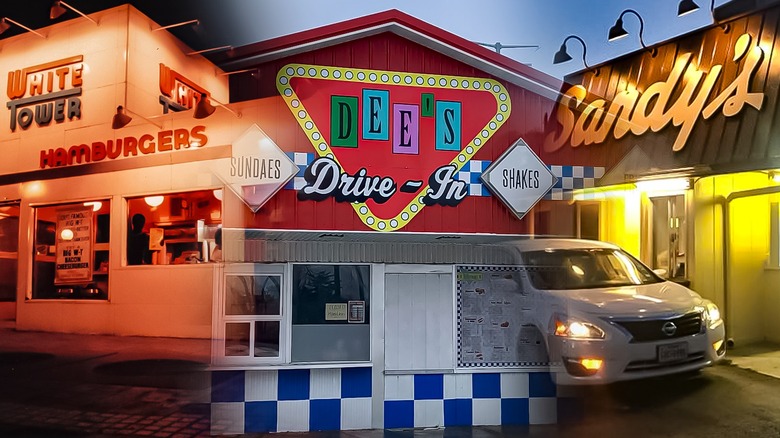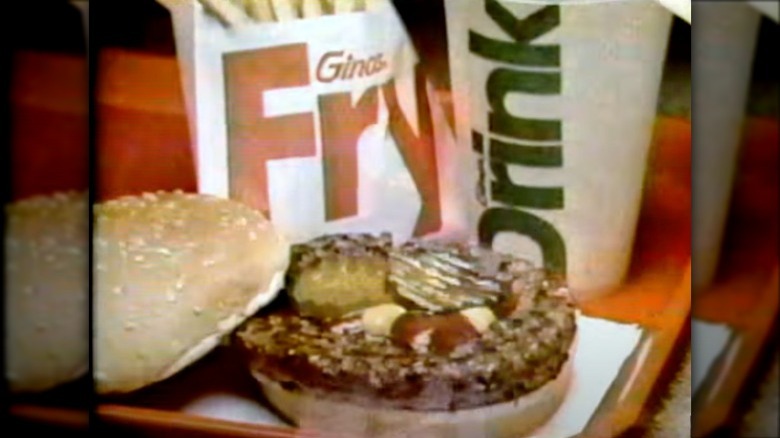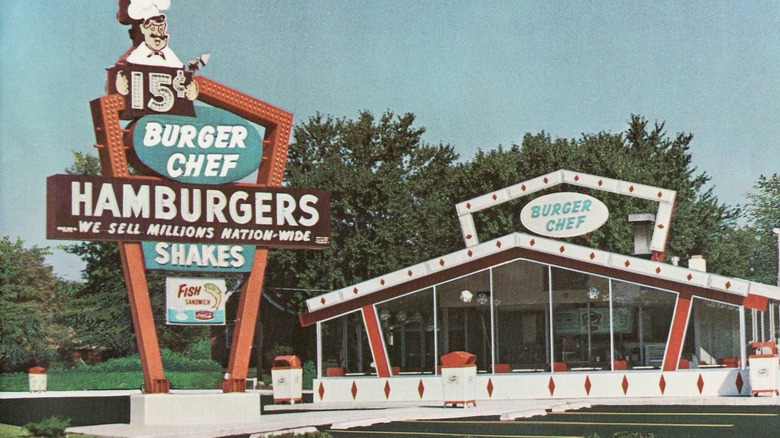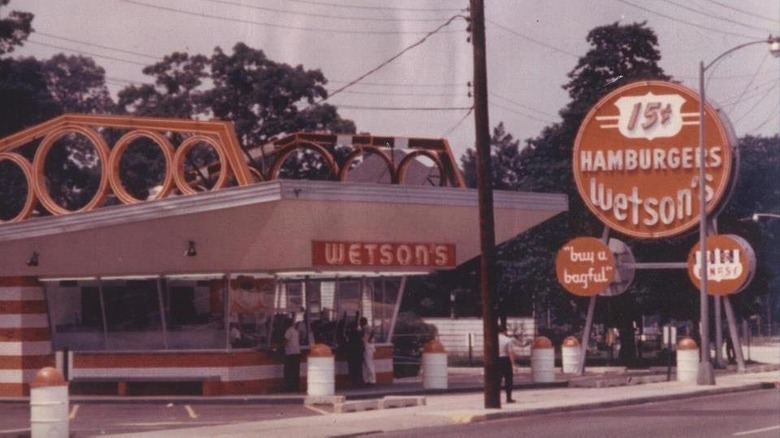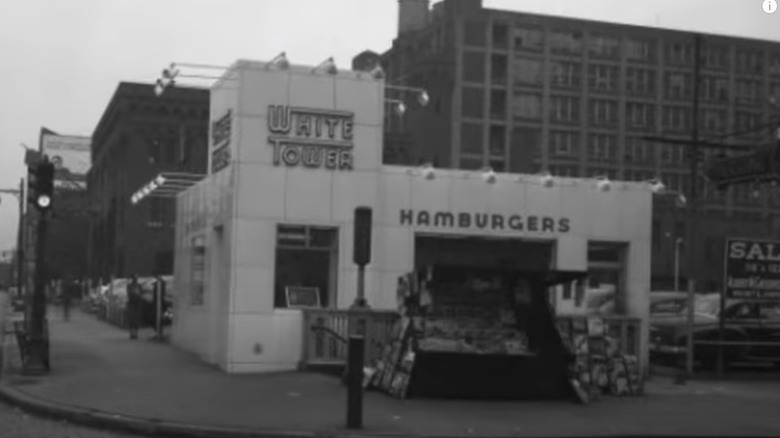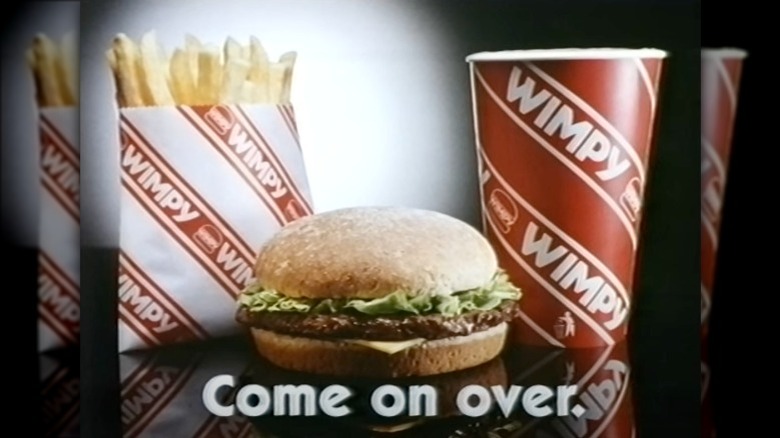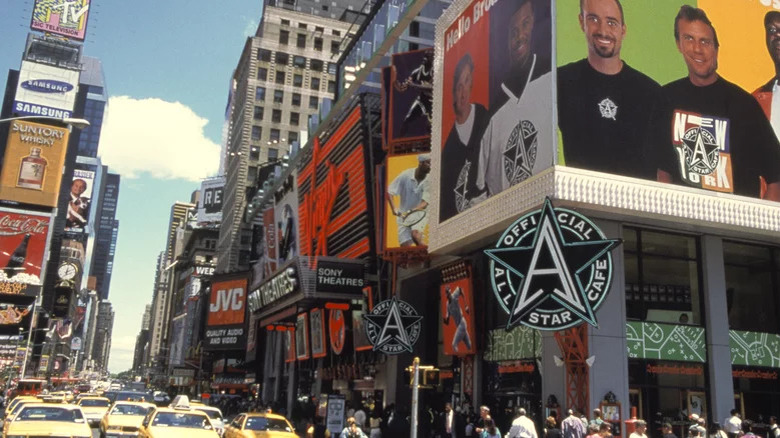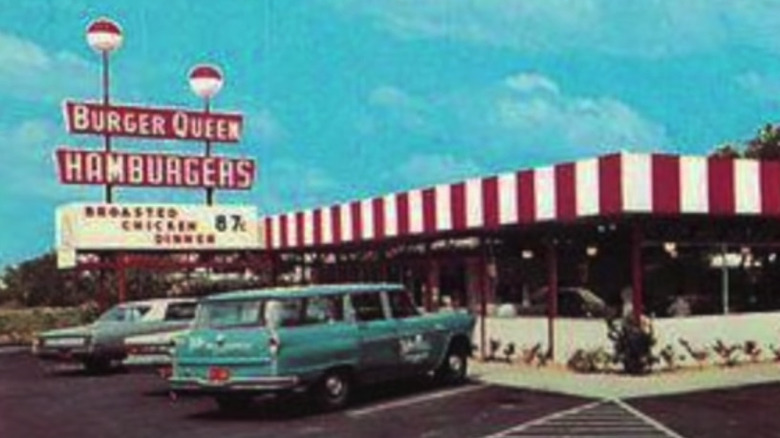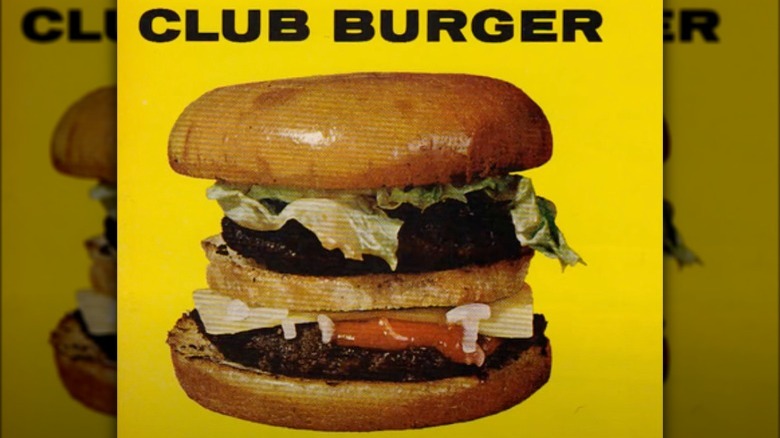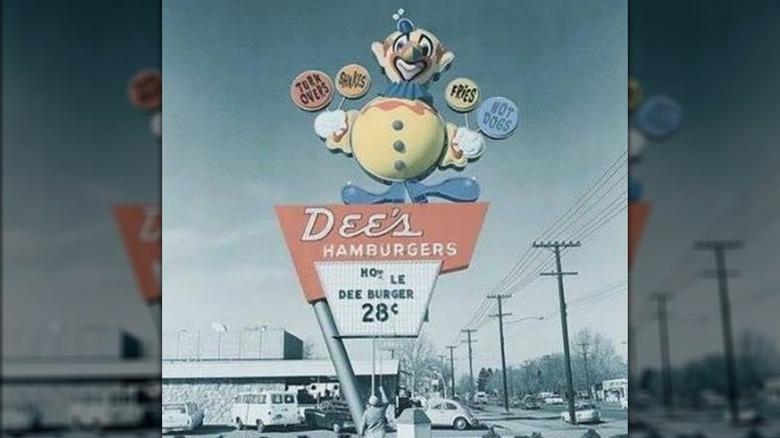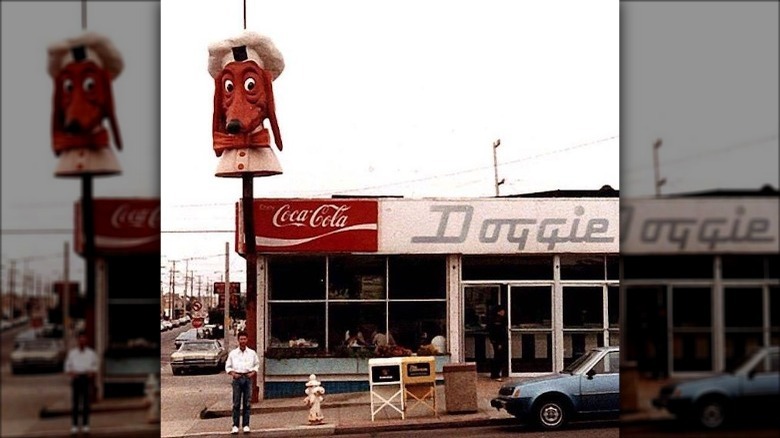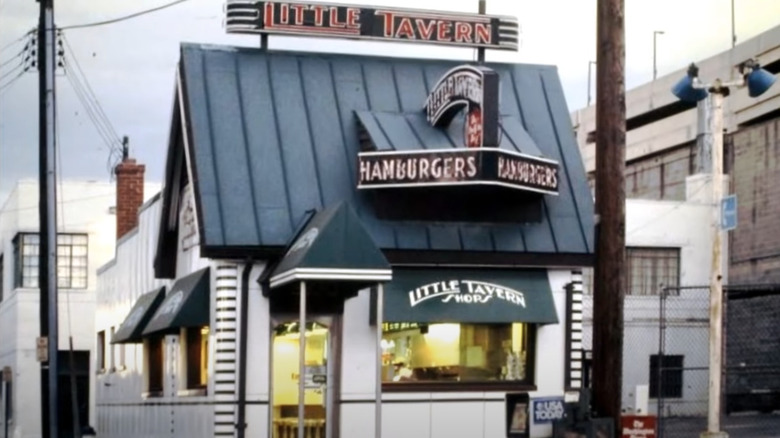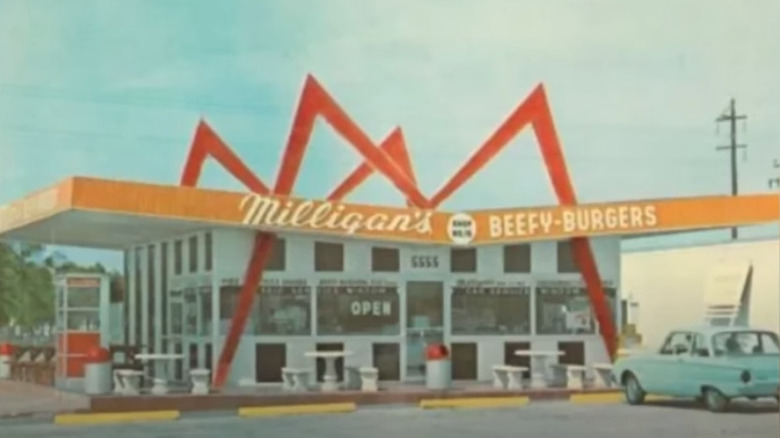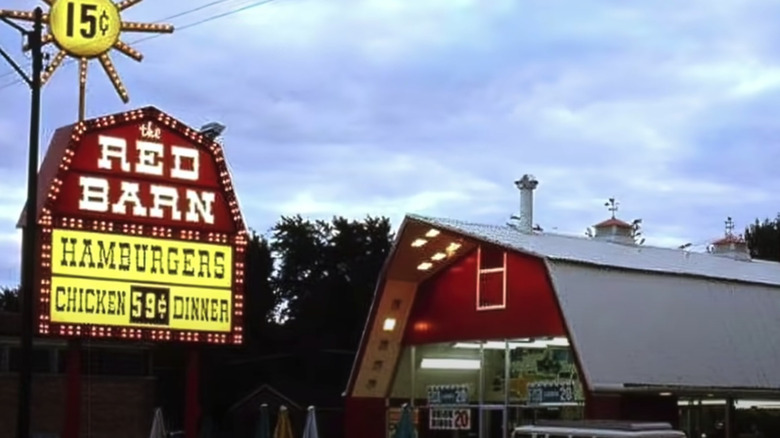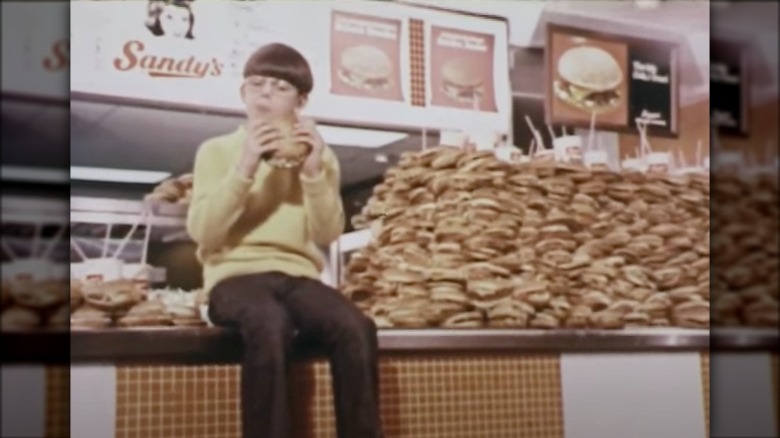Burger Chains That No Longer Exist
It's no secret we love our burgers. Whether it's our Big Macs, sliders, Whoppers, or smashed patties, the burger has long been a staple of the American diet. Everyone has their favorite burger joint, too. Some people need their Double Double fix from In-N-Out once a week, while others can't go long without satisfying their craving for a Culver's ButterBurger.
But while giants like McDonald's, Wendy's, and Burger King dominate the industry in terms of annual sales, it's important to pay homage to all the burger joints that paved the way for them to succeed in today's modern society. Although many of these spots closed long ago, they left an indelible mark for many of those who visited them during the good ol' days.
If you're ready to take your taste buds on a trip down memory lane, keep reading to revisit some of the most influential burger joints that no longer exist.
Gino's Burgers
Back the late 1950s, legendary NFL player Gino Marchetti teamed up with several other football players to open Gino's Hamburgers in Dundalk, Maryland. The packaging of sports and fast food was a winning combination. The burger joint quickly expanded to new locations in the East. The restaurant ended up merging with Tops Drive Inn, which changed its 18 sites into Gino's Drive-In locations in the Washington, D.C., area.
As the franchise grew, it ran into some issues. For one, Gino's struggled in Connecticut and Massachusetts where a pizza franchise — Papa Gino's — was already quite popular. These locations eventually shut down and were used for other chains. Gino's also ran into some trouble in the Midwest. For one Detroit location, the franchise planned on demolishing the historic Orchestra Hall to build a restaurant, but people weren't happy once they heard about it. A grassroots campaign formed against the company's plans, and the structure was eventually saved.
In 1982, the Marriott Corporation purchased the fast food chain and converted most of the locations into its Roy Rogers brand of restaurants. The final Gino's closed in 1986. More than 20 years later, several of the original owners got back together and relaunched a new line of restaurants: Gino's Burgers and Chicken.
Burger Chef
In Indianapolis, Indiana, brothers Donald and Frank Thomas owned General Equipment Company, which was hired by Burger King to manufacture a broiler to certain specifications. Donald and Frank were soon inspired to create their own fast food place. The first Burger Chef opened in 1957, and the rest is history.
The two brothers patented their flame broiler that was able to make 800 burgers an hour, so their 15-cent burgers quickly spread. Within 10 years, Burger Chef was the second-largest burger chain in the nation, right behind McDonald's. By 1972, it had about 1,200 locations. Burger Chef was arguably the pioneer when it came to kids' meals. The franchise created the Funburger, which was a smaller burger that included puzzles and a toy. Later, the franchise created the Funmeal, which included a burger, french fries, a soft drink, a sweet treat, and a toy. When McDonald's introduced its Happy Meal years later, Burger Chef sued but eventually lost.
By the late 1970s, the franchise was struggling financially. In 1982, 679 Burger Chef locations were sold to Hardee's for $44 million. Most of the locations were converted to Hardee's, while a few changed brands. Some independent Burger Chefs continued to operate for a few years afterward, and the final Burger Chef, located in Cookeville, Tennessee, shut down in 1996.
Apparently, Hardee's has brought Burger Chef burgers back from time to time at some of its Midwestern locations, if you're feeling nostalgic.
Wetson's
Those from the New York area probably remember the iconic Wetson's Hamburgers. The fast food chain was founded by brothers Herb and Errol Wetanson in 1959. They were inspired by the original McDonald's restaurant (and even copied one idea by having two clowns as mascots). When Herb returned home from the military, he explored Long Island, looking for the perfect location for his new burger joint. He realized Levittown shared many similarities to San Bernardino, where McDonald's was founded.
Wetson's was known for its signature burger called the "Big W" (which was pretty similar to the Big Mac), but the chain became famous for its 15-cent burgers and10-cent fries. However, once the big burger chains like McDonald's and Burger King began expanding into the New York metropolitan area, Wetson's couldn't compete. It merged in 1975 with Nathan's Famous, which led to the demise of the Long Island burger chain.
White Tower
When the White Castle fast-food hamburger chain became popular in the early 1920s, several imitators jumped on the bandwagon. Of those competitors, White Tower Hamburgers was probably the most successful. Founded in 1926, the copycat burger franchise went to great lengths to find out the secrets of White Castle, which included hiring ex-employees of White Castle, copying its uniforms, and using a similar architecture and design for the buildings. Even the slogan was suspiciously similar: White Castle's was "Buy 'Em By the Sack," and White Tower's was "Take Home a Bagful."
Even though it was a near-exact copy of White Castle, the White Tower Hamburgers franchise gained a following in Wisconsin and the surrounding areas. For decades, burgers and coffee both cost 5 cents each. White Tower even offered people free meals on Christmas Day "just to make sure that no single man, whether black or white, resident or transient, should go hungry" (via On Milwaukee).
White Castle eventually took the copycat company to court for trademark infringement and won. White Tower was ordered to change its architecture, keep out of White Castle's markets, and pay royalties to the copied brand. Surprisingly, White Tower's evolution into a modern coffee shop was well-timed, and the brand continued to see some success for awhile. However, the brand didn't keep up its business model for a car-filled, postwar America. When foot traffic decreased significantly, so did its business.
Wimpy
Back in 1934, a man named Edward Gold opened Wimpy Grills in Indiana. Where does its unique name come from? It was inspired by the character J. Wellington Wimpy from the popular Popeye cartoon. If you don't remember Wimpy, he was the burger maniac best known for the catchphrase: "I'll gladly pay you Tuesday for a hamburger today."
Although the burger joint originally started in Indiana, it was most notable in Chicago. By 1947, the chain was expected to sell about 8 million burgers a year from its locations in the Chicago area. At the time, White Castle was the biggest player in the game, but Wimpy burgers had a significant edge: You needed two hands to eat them. Its bigger burgers set Wimpy apart from the competition and allowed it to grow significantly.
Wimpy expanded internationally in 1954, and by 1970 Wimpy had become a favorite around the world with more than 1,000 locations in 23 countries. However, Wimpy's success in America faded away after Gold's death in 1977. The reasoning? No one had purchased the rights or trademark from Gold before he died — so the legend of Wimpy continues only overseas, where it is still licensed.
Official All-Star Cafe
If you grew up in the '80s and '90s, you likely remember the over-the-top sports bar called Official All-Star Cafe. The "sports bar Versailles" was the vision of Robert Earl, a businessman who specialized in creating themed restaurants like the Hard Rock Cafe and Planet Hollywood (via When Is Now). He enlisted some of the most successful athletes in the world, including Shaquille O'Neal, Wayne Gretzky, Monica Seles, Joe Montana, Tiger Woods, Ken Griffey Jr., and Andre Agassi.
Earl went all in on the first location in Manhattan's Times Square in 1995. One step into the restaurant was a smack to the senses. Over-the-top decor included mezzanine sky-box booths, an arena-sized scoreboard, booths shaped like baseball gloves, virtual reality video, and interactive TVs. You could also find rare sports memorabilia like Agassi's ponytail.
The franchise quickly expanded to Cancun, Miami, San Diego, Las Vegas, Australia, and Orlando's Disney World. Although the chain was a unique dining experience for tourists, it had a difficult time attracting people more than once. The last location closed in 2007. Now, the Official All-Star Cafe lives on only in the nation's memory as one of its flashier, more over-hyped disappointments.
Druther's (Burger Queen)
No, this isn't Burger King's wife. Burger Queen was a Florida restaurant opened by Harold and Helen Kite in 1956. The franchise expanded quickly and was sold five years later to James Gannon and John and George Clark. They brought the franchise to Kentucky, where it experienced its greatest success. You could see the burger joint from miles away due to its recognizable neon signs. Once you got a little closer, you'd be introduced to its mascot, Queenie Bee, and its signature burger — the Imperial.
At its peak, the chain had over 170 locations in Florida, Kentucky, Indiana, Illinois, and Tennessee. The franchise ran into some roadblocks, partly because of the disdain from Dairy Queen, which filed an injunction to prevent Burger Queen from selling any dairy products.
In 1981, the execs at Burger Queen decided to change the name to Druther's Restaurant to signal that its menu went beyond burgers. It also offered chicken, salads, and even fish. The franchise didn't get the boost it expected, however, and the company eventually changed all of its locations to Dairy Queens.
Carrols
Carrols was a branch of the Tastee-Freez chain that opened in 1956 in Indiana but blossomed with the help of a businessman named Herb Slotnick who secured the rights to add more locations. After seeing the burger stands in California, he envisioned bringing something similar to upstate New York. He soon became known as the man who introduced Syracuse to fast food, which included not only the chain's Club Burger but also its Sea Fillet fish sandwich, Crispy Country Chicken, and triple-thick shakes.
"Hamburgers were 15 cents and milkshakes were 15 cents and french fries were a dime, so it was 40 cents for a meal." Slotnick told Syracuse.com in 2010.
However, as most of these stories go, Carrols couldn't compete with the likes of Burger King and McDonald's. By the time the 1970s came around, Carrols was surrounded by ever-growing corporations. Slotnick made a business decision and cut a deal with Burger King. All of the Carrols locations in the U.S. were eventually either converted to Burger Kings or closed — the last American Carrols restaurant finally retired in 1981.
Dee's Drive-In
Before the big fast food franchises invaded Utah, a different kind of burger joint could be found all over the state: Dee's Drive-In. Highway drivers could see its giant neon clown signs that beckoned customers in, along with advertisements for Deeburgers, hot dogs, fries, and shakes.
The drive-in was founded by Dee Anderson, who started his restaurant career running a concession stand that sold his mom's sloppy joes at a carnival in his hometown. He learned good food would always bring people in. "The best sound of the carnival was when people said, 'Let's go to Dee's,'" he wrote in his autobiography that was cited by The Salt Lake Tribune. He opened his first Dee's restaurant in 1932. At the start, burgers were 5 cents apiece. Business skyrocketed due to what he claimed was the formula for success: "Absolute cleanliness, a menu of family favorites, fast service, quality food, and modest prices," he said via The Salt Lake Tribune.
At its peak, Dee's had more than 50 drive-ins. The franchise even had one location in South Africa, which was brought there by missionaries of LDS Church missions. It also was believed to be South Africa's first fast food restaurant. In 1982, Dee's Drive-In was sold to Hardee's, and its locations eventually became Apollo Burger or Carl's Jr. restaurants, but Dee's will always be a part of Utah's history.
Doggie Diner
One of the most interesting landmarks in California's Bay Area is Doggie Diner with its 10-food-tall fiberglass dog head wearing a bow tie and a chef's hat. The beloved chain's story began in 1948 in Oakland with a man named Al Ross. He opened the restaurant with one thing in mind: quality ingredients. It quickly grew in popularity with its Doggie Diner hot dogs, hamburgers, pastrami sandwiches, and milkshakes.
At one time the Bay Area franchise had 30 locations, most of which were open 24/7. Although there was "Nothing Finer Than Doggie Diner," according to its slogan, the last Doggie Diner shut its doors in 1986 after folding from the competition. However, several of the giant Doggie Diner busts survived through the years. One was refurbished and became a San Francisco landmark in 2005.
The good news is a man named Kip Atchley has made it his life's work to revive the beloved fast food chain. Apparently, it will be located in Napa and feature one of the Doggie Diner heads right along with it.
Little Tavern
In 1927, a little hamburger chain was established in Louisville, Kentucky, by a man named Harry F. Duncan. It was called Little Tavern — and that's exactly what it looked like. The burger joint opened five locations that first year. The following year, Duncan moved to Washington, D.C., and opened several more. At its peak, more than 50 Little Taverns operated in the Baltimore/D.C. area.
The small burger shops served slider-sized, square burgers with onions, dill pickles, and ballpark mustard. The restaurant held the slogan: "Buy 'Em By the Bag" (which was suspiciously close to White Castle's "Buy 'Em By the Sack"). The five-cent burgers were a hit. Teenagers called it "Club LT," according to Baltimore Heritage.
The burger chain persisted for more than half a century, but by the 1990s, the business saw financial hardships. The last Little Tavern closed in 2008, although that Maryland location did reopen later as Laurel Tavern Donuts — where you can still find the chain's original hamburger recipe.
Milligan's Beefy Burgers
Cities all over the country had their humble introductions to fast food burgers through one of many startup restaurants. For Jacksonville, Florida, it was Milligan's Beefy Burgers. A couple by the name of Elmer and Dorothy Milligan opened a burger joint that became an instant hit there — they sold over 450,000 beefy burgers that first year. After firmly establishing the chain in Jacksonville, the couple expanded to other locations around the county. By 1964, it had 16 locations and served more than 5 million burgers a year.
Back then, you could get a sackful (otherwise known as a dozen) of beefy burgers for a dollar. However, the franchise started to lose business once McDonald's and Burger King entered its territory. Jacksonville's Burger King especially flourished, with its headquarters in nearby Miami. Although most records of Milligan's Beefy Burgers has faded away as the decades passed, the burger joint will always have its place as one of the first fast food burger joints in Jacksonville.
Red Barn
In Ohio, Red Barn's catchy jingle dominated the airwaves: "When the hungries hit, when the hungries hit, hit the Red Barn" (via Cleveland Vintage). The popular fast food chain was founded in 1961 by friends Jim Kirst, Don Six, and Martin Levine. People would head to Red Barn for a Big Barney (which, according to some, actually preceded the Big Mac). It also served fish sandwiches and fried chicken and had a salad bar, which was a novel strategy in those days.
At one point, the burger joint had more than 300 locations in 19 states. It even had locations in Canada and Australia as well. In the late 1960s, a company called United Servomation purchased Red Barn but didn't give it the attention it needed to succeed. The final franchisee's lease ended in 1988.
One regular from Rochester, New York, reminisced with the Democrat & Chronicle that "the Red Barn across from East High [School] was a hangout for area kids. My friends and I pretty much ran that place ... it was one of our central homes/bases in that neighborhood." Although Red Barn was yet another chain that lost out to bigger burger franchises, it will forever have a home in the hearts of many Americans.
Sandy's
In Illinois, Gus Lundberg, Robert Wenger, Paul White, and W.K. Davidson started a fast food burger joint. The four entrepreneurs hadn't intended to create their own restaurant chain. They were planning on opening some of the first McDonald's franchises outside of California. After their first McDonald's in Urbana, Illinois, was a hit, they decided to open new ones in Decatur and Peoria, Illinois. However, Ray Kroc of McDonald's informed them of several changes to the terms that would result in them paying a much higher percentage to McDonald's. So instead, the men decided to build a Scottish-based fast food joint they called Sandy's.
The place was popular. It served 15-cent hamburgers, 20-cent milkshakes, and a 10-cent bag of fries (which was strikingly similar to the McDonald's menu). Although the four founders weren't initially interested in expanding their local restaurant, the chain ended up with more than 100 locations around the nation (even as Kroc was busy suing them).
Eventually, the Scottish burger restaurant was sold to Hardee's in 1971, but not before expanding to other countries like Belgium and Canada. Although it's gone, the spirit of Sandy's will always be a part of history.
